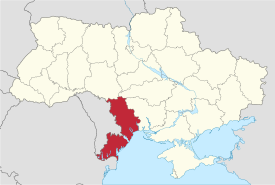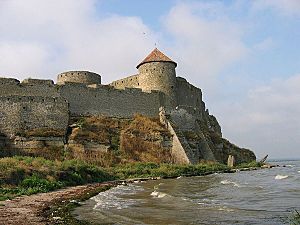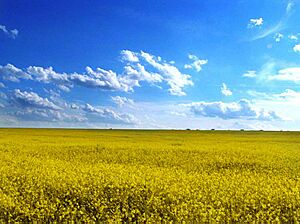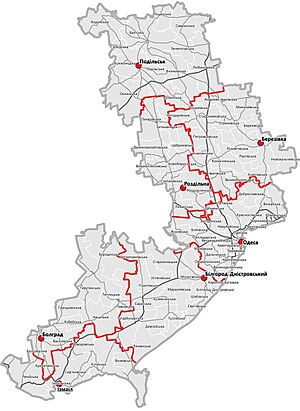Odesa Oblast facts for kids
Quick facts for kids
Odesa Oblast
Одеська область
|
|||
|---|---|---|---|
| Odeska oblast | |||
|
|||
 |
|||
| Country | |||
| Administrative center | Odesa | ||
| Area | |||
| • Total | 33,313.69 km2 (12,862.49 sq mi) | ||
| Area rank | Ranked 1st | ||
| Population
(2022)
|
|||
| • Total | |||
| • Rank | Ranked 6 | ||
| Time zone | UTC+2 (EET) | ||
| • Summer (DST) | UTC+3 (EEST) | ||
| Postal code |
65000-68999
|
||
| Area code | +380-48 | ||
| ISO 3166 code | UA-51 | ||
| Raions | 26 | ||
| Cities (total) | 19 | ||
| • Regional cities | 7 | ||
| Urban-type settlements | 33 | ||
| Villages | 1138 | ||
| FIPS 10-4 | UP17 | ||
Odesa Oblast (also called Odeshchyna) is a large region, or oblast, in southwestern Ukraine. It's located right along the northern coast of the Black Sea. The main city and administrative center of the region is Odesa. About 2.35 million people live here.
This region has a long coastline, stretching about 300 kilometers (186 miles) along the sea and estuaries. Its border with other countries is even longer, about 1,200 kilometers (746 miles). Odesa Oblast is home to eight seaports and five of Ukraine's biggest lakes, including Yalpuh Lake. It's also the biggest wine-growing area in Ukraine, with over 80,000 hectares (197,684 acres) of vineyards.
Contents
A Look at Odesa Oblast's Past
The Odesa region has a very old history, with people living here for thousands of years.
Early Settlements and Ancient Cultures
The first signs of people living here come from the Neolithic Age. We've found old settlements and burial sites from cultures like Gumelnița, Cucuteni-Trypillia, and Usatove. Later, during the Bronze Age, there were Proto-Indo-Europeans who left behind burial mounds and hoards of treasures.
Around 1000 B.C., Milesian Greeks started building colonies along the Black Sea coast. Important Greek towns included Olbia, Tyras, and Chersonesus. These Greeks left behind beautiful painted pots, sculptures, and other art, showing how advanced their civilization was.
Scythians, Sarmatians, and Slavs
The Scythians were tribes who lived in the steppes (grassy plains) near the Black Sea around 1000 B.C. They left behind artifacts like weapons, bronze pots, and jewelry. Later, the Sarmatians took their place. In the 3rd and 4th centuries A.D., a new group formed, known through the Chernyakhov culture.
Around the middle of the first millennium, the Slavic people began to form. By the 9th century, the eastern Slavs created a state with Kyiv as its center, known as Kievan Rus'. During this time, the Slavs lived alongside groups like the Khazars, Polovtsy, and Pechenegs. We know about this period from archaeological finds in places like Belgorod and Berezan Island.
Later Rulers and Modern Times
In the 13th century, the Mongols took control of the Black Sea coast. Later, parts of the region were controlled by the Republic of Genoa (around 1290) and then the Grand Duchy of Lithuania (early 15th century).
In 1593, the Ottoman Empire took over, calling it the Dnieper Province. By 1791, the area came under Russian control as Russia expanded towards the Black Sea.
After the February Revolution in Russia in 1917, the area became part of the Ukrainian People's Republic. However, it soon fell to different armies during the Russian Civil War, eventually becoming part of the Ukrainian SSR (Soviet Ukraine) by 1920. Odesa Oblast was officially created on February 27, 1932.
During World War II, Axis forces took over the area. Romania then controlled it from 1941 to 1944. After the war, the Soviet government brought the oblast back to its pre-war borders. In 1954, Odesa Oblast grew even larger when it absorbed Izmail Oblast, which was also known as the Budjak region.
In the 1991 referendum, most people in Odesa Oblast (85.38%) voted for Ukraine to be independent. More recently, in 2022, Switzerland promised to help rebuild the Odesa region after the ongoing conflict.
Exploring Odesa Oblast's Geography
Odesa Oblast is the largest region in Ukraine by area, covering about 33,314 square kilometers (12,863 square miles).
Landscapes and Natural Features
The region is mostly made up of flat steppes, which are part of the Black Sea Lowland. The Dniester river estuary divides these plains, and the Danube river borders the region to the south.
The Black Sea coast here has many sandy beaches, estuaries (where rivers meet the sea), and lagoons. The soil in Odesa Oblast, especially the rich chernozems (black earth), is very fertile. This makes agriculture a huge part of the local economy. In the southwest, you'll find many orchards and vineyards, while other crops are grown throughout the region.
Cool Places to Visit in Odesa Oblast
- Odesa Opera: A beautiful and historic opera house.
- Akkerman fortress: An ancient and impressive fortress with a long history.
- Potemkin Stairs: Famous giant steps in Odesa, leading down to the port.
Odesa Oblast's Economy
The economy of Odesa Oblast is strong in several key areas:
- Oil and Chemicals: There's a lot of oil refining and chemical processing happening here.
- Transportation: The region has important sea and river ports, oil pipelines, and railways, making it a major transport hub.
- Agriculture: Wine-making is very important. Farmers also grow crops like wheat, maize (corn), barley, sunflowers, and sugar beets.
Most of the region's industrial activities are centered in and around the city of Odesa.
People of Odesa Oblast
As of early 2021, the oblast had about 2,368,107 people. Almost half of them (about 43%) live in the city of Odesa itself.
Diverse Communities
Odesa Oblast is home to several minority groups. There are significant Bulgarian (6.1%) and Romanian (5.0%) communities. It also has the highest percentage of Jews of any region in Ukraine, and a small Greek community in Odesa city.
In the Budjak area (a part of Odesa Oblast), Bulgarians make up 21% of the population and Romanians make up 13%.
Religious Beliefs
The main religion in Odesa Oblast is Eastern Orthodox Christianity, followed by 84% of the people. About 8% say they don't have a religion, and 6% identify as unaffiliated Christians. Smaller groups include Catholics and Protestants, each making up about 0.5% of the population.
Religion in Odesa Oblast (2015) Eastern Orthodoxy (84%) No religion (8%) Unaffiliated Christian (6%) Catholicism (0.5%) Protestantism (0.5%) Undecided (1%)
How Odesa Oblast is Organized
Before 2020, Odesa Oblast was divided into 26 raions (districts) and 7 cities that reported directly to the oblast government. These cities included Odesa, Bilhorod-Dnistrovskyi, Chornomorsk, Izmail, Podilsk, Teplodar, and Yuzhne.
In a big change on July 18, 2020, the number of districts (raions) was reduced to seven. These new, larger raions now also include the cities that used to be independent. These seven raions are further divided into 91 smaller local communities called hromadas.
Here are the main new raions:
- Berezivka Raion
- Bilhorod-Dnistrovskyi Raion
- Bolhrad Raion
- Izmail Raion
- Odesa Raion
- Podilsk Raion
- Rozdilna Raion
Famous People from Odesa Oblast
Many notable people have come from Odesa.
- Sergei Utochkin was a famous sportsman from Odesa. He was amazing at cycling, boxing, swimming, and even played football. He was known for his incredible challenges, like racing a steam tram while running, beating a galloping horse on a bicycle, and passing a cyclist on roller skates! He later became a pilot and even built his own airplane. He performed flights for huge crowds, including a young Igor Sikorsky, who would later invent helicopters.
Other famous people born in Odesa include:
- The poet Anna Akhmatova.
- Former NASA scientist Nicholas E. Golovin, who worked on the Apollo program.
- Composer Tamara Maliukova Sidorenko.
- Leonid Utyosov, who is known as the founder of jazz music in the Soviet Union.
See also
 In Spanish: Óblast de Odesa para niños
In Spanish: Óblast de Odesa para niños
- Subdivisions of Ukraine
- Budjak
- Transnistria
- Gagauzia
- Bessarabia
- Moldova
- Romania
- Ukraine
- Black Sea






